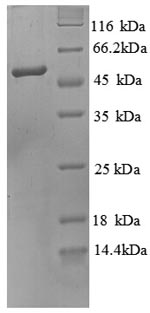Amino acids 5-451 form the expressed segment for recombinant Human SEPSECS. The expected molecular weight for the SEPSECS protein is calculated to be 53.4 kDa. This SEPSECS recombinant protein is manufactured in e.coli. The N-terminal 6xHis tag was fused into the coding gene segment of SEPSECS, making it easier to detect and purify the SEPSECS recombinant protein in the later stages of expression and purification.
The human O-phosphoseryl-tRNA (Sec) selenium transferase (SEPSECS) is an essential enzyme involved in the biosynthesis of selenocysteine (Sec), a rare amino acid that contains selenium. SEPSECS plays a crucial role in the unique mechanism by which selenocysteine is incorporated into proteins during translation. SEPSECS catalyzes the conversion of O-phosphoseryl-tRNA (Sec) to selenocysteinyl-tRNA (Sec), a key step in the synthesis of selenoproteins. Selenoproteins are involved in various biological processes, including antioxidant defense and redox regulation. Research on SEPSECS focuses on understanding its role in selenocysteine biosynthesis, the regulation of selenoprotein expression, and the impact of selenoproteins on cellular functions.






